SPECTRE (2015, Dir. Sam Mendes):
The twenty men who looked up the long table at this man and waited patiently for him to speak were a curious mixture of national types. But they had certain characteristics in common. They were all in the thirty-to-forty age group, they all looked extremely fit, and nearly all of them had quick, hard, predatory eyes, the eyes of the wolves and the hawks that prey upon the herd…
These men, all experts in conspiracy, in the highest ranges of secret communication and action and, above all, of silence, also shared one supreme virtue — every man had a solid cover. Every man possessed a valid passport with up-to-date visas for the principal countries in the world, and an entirely clean sheet with Interpol and with their respective national police forces. That factor alone, the factor of each man’s cleanliness after a lifetime in big crime, was his highest qualification for membership of SPECTRE — The Special Executive for Counterintelligence, Terrorism, Revenge and Extortion.
— Ian Fleming, Thunderball
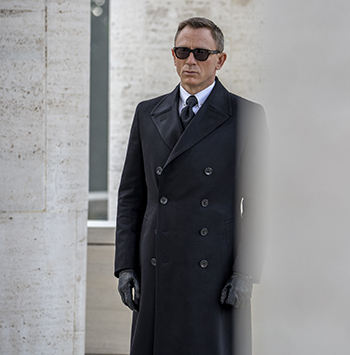 Like oft-told myths, legends and fairy tales, James Bond films have stuck to a certain template. A lone hero of unspecified origins but very specific tastes sallies forth like St. George to slay the dragon and set the world to right, but not without having fun along the way — some kinky thrills, a few inventive deaths, a dollop of sadism spiced with saucy elegance, all shaken and stirred together. While the quality of each film might vary depending on the quantities of individual ingredients, the ingredients themselves never change.
Like oft-told myths, legends and fairy tales, James Bond films have stuck to a certain template. A lone hero of unspecified origins but very specific tastes sallies forth like St. George to slay the dragon and set the world to right, but not without having fun along the way — some kinky thrills, a few inventive deaths, a dollop of sadism spiced with saucy elegance, all shaken and stirred together. While the quality of each film might vary depending on the quantities of individual ingredients, the ingredients themselves never change.
But that was before Daniel Craig’s reign as James Bond, which has been nothing if not eventful. Casino Royale (2006) introduced the notion of Bond as an actual human with an actual progression, a man who doesn’t necessarily forget the hurts and travails of the previous movie. Skyfall (2012) took it a step further, referencing Bond’s past directly for the first time. 007 was a three-dimensional character at last — but such an approach also heightened the stakes. Before, a bad Bond movie could be forgotten about within minutes of leaving the cinema; now, a negative Bond experience could adversely affect all the other movies in the chain. Thus we have the crushing disappointment of Quantum of Solace (2008), which wasted the foundation of what Casino Royale had built. Skyfall was another reboot within the reboot, fast-forwarding Bond to later in his career, and laying the emphasis on theme and character motivation. The result? Box office bonanza, the first $1 billion Bond movie. After 50 years of executing thousands of assassins, shagging hundreds of lovelies, and thwarting dozens of plans for world domination, Bond was in danger of becoming something he had never been before: respectable. Everywhere you looked on the Skyfall cast and crew list, you found Oscar nominees or winners — director Sam Mendes, cinematographer Roger Deakins, composer Thomas Newman, Judi Dench and Javier Bardem. The result, as you would expect, was a tasteful, handsomely mounted production.
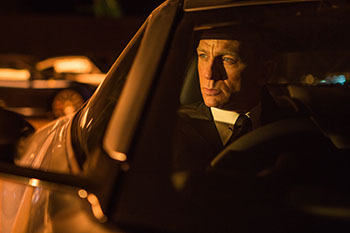 Only one problem: Was Bond ever meant to be tasteful? To Ian Fleming, the concept of the character was pure snobbery. Bond was always a ruthless assassin with pretensions of discernment, a hollow man who nevertheless had the privilege of partaking of all the drink, women and violence that were available. The romance of 007 resides in that frisson between his callousness and his heroism — in Fleming’s world of diabolical evildoers, it takes a bastard to defeat the bastards. While Craig has been especially adept at capturing the dichotomy at the heart of Bond, his movies have tended to let him down when it comes to setting his performance in an appropriately colorful universe. Although Casino Royale proved you could have a Bond movie which peeked into the dark aspects of the man’s soul while still leaving room for pulpy adventure, Quantum of Solace went spastic on the pace and action, lacking a compelling emotional throughline for its lead. In response, Skyfall lollygagged it on plot (yes, Bond plots are not renowned for their legibility, but this one has holes big enough to drive an 18-wheeler through) and went all in on the psychological underpinnings, as everyone from M to the villain had personal stakes in the story. Less spy adventure than protracted chamber drama (not a surprise given Mendes’ theater chops), Skyfall sat well with the cinema cognoscenti, but it also leeched away much of what makes these movies fun. By all means, give Bond depth, but isn’t it more exhilarating to triumph over a flamboyant bad guy than it is to defeat a flamboyant bad guy who’s afflicted with mommy issues?
Only one problem: Was Bond ever meant to be tasteful? To Ian Fleming, the concept of the character was pure snobbery. Bond was always a ruthless assassin with pretensions of discernment, a hollow man who nevertheless had the privilege of partaking of all the drink, women and violence that were available. The romance of 007 resides in that frisson between his callousness and his heroism — in Fleming’s world of diabolical evildoers, it takes a bastard to defeat the bastards. While Craig has been especially adept at capturing the dichotomy at the heart of Bond, his movies have tended to let him down when it comes to setting his performance in an appropriately colorful universe. Although Casino Royale proved you could have a Bond movie which peeked into the dark aspects of the man’s soul while still leaving room for pulpy adventure, Quantum of Solace went spastic on the pace and action, lacking a compelling emotional throughline for its lead. In response, Skyfall lollygagged it on plot (yes, Bond plots are not renowned for their legibility, but this one has holes big enough to drive an 18-wheeler through) and went all in on the psychological underpinnings, as everyone from M to the villain had personal stakes in the story. Less spy adventure than protracted chamber drama (not a surprise given Mendes’ theater chops), Skyfall sat well with the cinema cognoscenti, but it also leeched away much of what makes these movies fun. By all means, give Bond depth, but isn’t it more exhilarating to triumph over a flamboyant bad guy than it is to defeat a flamboyant bad guy who’s afflicted with mommy issues?
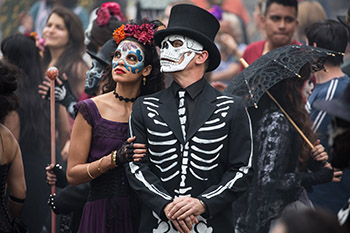 Which brings us to SPECTRE, which sets up a three-fold challenge for itself. It wants to tie all the threads of the Craig era together into a cogent summation, maintain the dramatic pull that roped so many people into Skyfall, and bring more Bondian swagger to the proceedings. Your heart might sink when we’re informed by a portentous title card, “The dead are alive” (in case we weren’t aware what today’s topic will be), but then the movie begins with a bang and a clatter, suggesting that adrenalized entertainment is back on the menu, at least. In a five-minute tracking shot from Orson Welles’ Touch of Evil playbook, we follow Bond through a ginormous Day of the Dead parade in Mexico City, into a hotel room with a would-be conquest, and then out onto a rooftop ledge for an assassination. As with all the archetypal Bond openers, we have gallows humor (“To death,” Bond’s target toasts his fellow conspirators; “Bottoms up,” agrees Bond just before he shoots him from across the street), a few references to the past (the skeletons on parade are reminiscent of Live and Let Die, Mendes’ personal favorite Bond movie), destruction of local property, and the wry proficiency of Bond himself (as a building collapses around him, he springs cat-like to safety, but not before an unexpected tumble onto a sofa). In case that bit of bravura isn’t enough, it’s followed up with a gloriously inflated brawl inside an out-of-control helicopter. Thanks to an assignment from the previous M (Judi Dench) from beyond the grave, and a secret ring purloined from the finger of his quarry, Bond is placed on the trail of the granddaddy of all criminal organizations (perfect timing too — the Bond producers got the rights to use SPECTRE again just a few years ago), and we’re off to the usual glamorous locations: Rome, the Austrian Alps, and Morocco. Meanwhile, back in London, the MI-6 crew have their own problems. M (Ralph Fiennes), Moneypenny (Naomi Harris) and Q (Ben Whishaw) are faced with irrelevance, thanks to a Whitehall mandarin (Andrew Scott) ready to inaugurate a new world of total surveillance (insert Edward Snowden anxieties here). Could these two plotlines possibly be linked? Relax and enjoy that martini; of course they are.
Which brings us to SPECTRE, which sets up a three-fold challenge for itself. It wants to tie all the threads of the Craig era together into a cogent summation, maintain the dramatic pull that roped so many people into Skyfall, and bring more Bondian swagger to the proceedings. Your heart might sink when we’re informed by a portentous title card, “The dead are alive” (in case we weren’t aware what today’s topic will be), but then the movie begins with a bang and a clatter, suggesting that adrenalized entertainment is back on the menu, at least. In a five-minute tracking shot from Orson Welles’ Touch of Evil playbook, we follow Bond through a ginormous Day of the Dead parade in Mexico City, into a hotel room with a would-be conquest, and then out onto a rooftop ledge for an assassination. As with all the archetypal Bond openers, we have gallows humor (“To death,” Bond’s target toasts his fellow conspirators; “Bottoms up,” agrees Bond just before he shoots him from across the street), a few references to the past (the skeletons on parade are reminiscent of Live and Let Die, Mendes’ personal favorite Bond movie), destruction of local property, and the wry proficiency of Bond himself (as a building collapses around him, he springs cat-like to safety, but not before an unexpected tumble onto a sofa). In case that bit of bravura isn’t enough, it’s followed up with a gloriously inflated brawl inside an out-of-control helicopter. Thanks to an assignment from the previous M (Judi Dench) from beyond the grave, and a secret ring purloined from the finger of his quarry, Bond is placed on the trail of the granddaddy of all criminal organizations (perfect timing too — the Bond producers got the rights to use SPECTRE again just a few years ago), and we’re off to the usual glamorous locations: Rome, the Austrian Alps, and Morocco. Meanwhile, back in London, the MI-6 crew have their own problems. M (Ralph Fiennes), Moneypenny (Naomi Harris) and Q (Ben Whishaw) are faced with irrelevance, thanks to a Whitehall mandarin (Andrew Scott) ready to inaugurate a new world of total surveillance (insert Edward Snowden anxieties here). Could these two plotlines possibly be linked? Relax and enjoy that martini; of course they are.
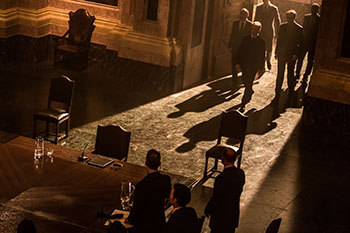 Bond movies are at their best when there’s an urgency to the narrative, and SPECTRE‘s premise suggests a forward momentum that was missing in Skyfall. All the ingredients are there for a zestier mix: a car chase through nocturnal Rome, an elaborate pursuit with a plane versus Land Rovers, a fatal meeting with an old enemy (Jesper Christensen’s reliably creepy Mr. White), an assignation with a villain’s widow (Monica Bellucci, voluptuous as ever and woefully underused), and a trail of clues that leads Bond in classic fashion straight into his enemy’s web. Mendes remains above all a theatrical director — the film’s better moments tend to be the ones in which he sets his actors up like pieces on a chessboard and eases back to let us enjoy the view, as when Bellucci glides out into the courtyard of her villa, awaiting execution, her two assassins flanking her in the frame. Although the somber cinematography by Hoyte van Hoytema is no match for Roger Deakins’ work in Skyfall, there’s no doubt he can compose some pretty frames, including a secret meeting of SPECTRE inside a boardroom of the damned, all chiaroscuro and candlelight.
Bond movies are at their best when there’s an urgency to the narrative, and SPECTRE‘s premise suggests a forward momentum that was missing in Skyfall. All the ingredients are there for a zestier mix: a car chase through nocturnal Rome, an elaborate pursuit with a plane versus Land Rovers, a fatal meeting with an old enemy (Jesper Christensen’s reliably creepy Mr. White), an assignation with a villain’s widow (Monica Bellucci, voluptuous as ever and woefully underused), and a trail of clues that leads Bond in classic fashion straight into his enemy’s web. Mendes remains above all a theatrical director — the film’s better moments tend to be the ones in which he sets his actors up like pieces on a chessboard and eases back to let us enjoy the view, as when Bellucci glides out into the courtyard of her villa, awaiting execution, her two assassins flanking her in the frame. Although the somber cinematography by Hoyte van Hoytema is no match for Roger Deakins’ work in Skyfall, there’s no doubt he can compose some pretty frames, including a secret meeting of SPECTRE inside a boardroom of the damned, all chiaroscuro and candlelight.
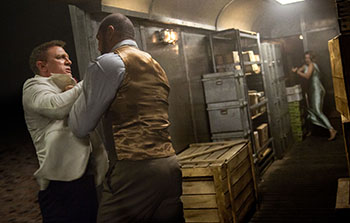 While Mendes makes everything look high-class — no surprise there — he’s far less successful at loosening his collar for the action scenes. Vintage Bond usually married wit with razor-exact editing, and more recent Bond films have successfully ratcheted up the intensity (take anything from Martin Campbell’s Casino Royale as an example). SPECTRE‘s setpieces are too finicky and mild-mannered to satisfy in either direction. The sight of cars drifting across Roman cobblestone should bring a visceral thrill, but the camera setups and Lee Smith’s editing lack pop. Even more puzzling is the decision to cross-cut the movie’s setpieces with shots of the MI-6 crew doing their thing, much like Christopher Nolan likes to volleyball between parallel action in his films. Thus what should be an ever-escalating car chase is intercut with Moneypenny talking to Bond on the phone while she peeks into her fridge — good for an intellectual chuckle maybe, but it doesn’t do much to get our hearts racing. Later, Bond commandeers a prop plane in a desperate scramble to save Madeleine Swann (Lea Seydoux) from the clutches of henchman Hinx (David Bautista), and every time the action threatens to (ahem) take off, we cut to Q slumped in a ski gondola, being ogled at by a SPECTRE goon. A train-bound tussle between Bond and Hinx turns out to be the film’s action highlight; a fond reminder of From Russia with Love and The Spy Who Loved Me, it’s the only scene filmed with the syncopation and blunt-force directness of the glory days.
While Mendes makes everything look high-class — no surprise there — he’s far less successful at loosening his collar for the action scenes. Vintage Bond usually married wit with razor-exact editing, and more recent Bond films have successfully ratcheted up the intensity (take anything from Martin Campbell’s Casino Royale as an example). SPECTRE‘s setpieces are too finicky and mild-mannered to satisfy in either direction. The sight of cars drifting across Roman cobblestone should bring a visceral thrill, but the camera setups and Lee Smith’s editing lack pop. Even more puzzling is the decision to cross-cut the movie’s setpieces with shots of the MI-6 crew doing their thing, much like Christopher Nolan likes to volleyball between parallel action in his films. Thus what should be an ever-escalating car chase is intercut with Moneypenny talking to Bond on the phone while she peeks into her fridge — good for an intellectual chuckle maybe, but it doesn’t do much to get our hearts racing. Later, Bond commandeers a prop plane in a desperate scramble to save Madeleine Swann (Lea Seydoux) from the clutches of henchman Hinx (David Bautista), and every time the action threatens to (ahem) take off, we cut to Q slumped in a ski gondola, being ogled at by a SPECTRE goon. A train-bound tussle between Bond and Hinx turns out to be the film’s action highlight; a fond reminder of From Russia with Love and The Spy Who Loved Me, it’s the only scene filmed with the syncopation and blunt-force directness of the glory days.
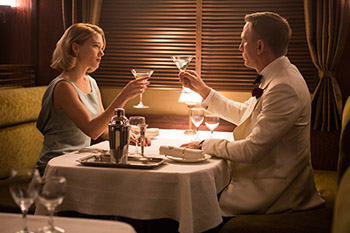 It’s clear that Mendes has taken the title of the movie to heart: SPECTRE is the organization behind all of Craig’s previous woes as Bond, and we’re meant to feel the presence of the ghosts from his preceding movies, hovering like dark mist over the action. The story is way too busy to support such a mood, though. We’re constantly thrown back to London to endure exposition, chippy board meetings, and political debates between Fiennes and Scott (who is far too shifty for us not to believe he’s one of the bad guys from the start). And as for ghosts, the references to Bond’s dead comrades are handled in ham-fisted fashion (a lotta name checks and photos mostly). Sluggish when it should be accelerating, pensive when it should be nightmarish, the film aims for the surreal impact of some of the vintage Bond adventures, but lacks their visual flair or verve. What one would give for a little more balls (for lack of a better word) to the whole affair, whether it’s the soundtrack (Thomas Newman reheats some pretty leftovers from his Skyfall score, but the lyrical bravado of John Barry is a distant memory — we won’t even get into Sam Smith’s title song), the film’s palette (which restricts itself to dusty grays and browns), or more vitality in the overall pace. For a good while, though, we can sit back and enjoy the show for what it is, and that’s due to Craig, who turns in his most confident performance yet. While the twinkle in his eye remains the hard glitter of a hitman rather than the sparkle of a bon vivant, his Bond finally seems at peace with the idea that he’s functioning in a crazy world of would-be criminal geniuses (“Our psychiatric wards are full of them,” he quips) and far-out occurrences. You wouldn’t be able to imagine the Bond of Casino Royale interrogating a mouse, and yet here he is doing so, and it also happens to be one of the funniest bits in the movie. He’s well-matched with Seydoux, whose fiery vulnerability brings out his protective side — their scenes together might straggle when it comes to character development, but their chemistry is palpable.
It’s clear that Mendes has taken the title of the movie to heart: SPECTRE is the organization behind all of Craig’s previous woes as Bond, and we’re meant to feel the presence of the ghosts from his preceding movies, hovering like dark mist over the action. The story is way too busy to support such a mood, though. We’re constantly thrown back to London to endure exposition, chippy board meetings, and political debates between Fiennes and Scott (who is far too shifty for us not to believe he’s one of the bad guys from the start). And as for ghosts, the references to Bond’s dead comrades are handled in ham-fisted fashion (a lotta name checks and photos mostly). Sluggish when it should be accelerating, pensive when it should be nightmarish, the film aims for the surreal impact of some of the vintage Bond adventures, but lacks their visual flair or verve. What one would give for a little more balls (for lack of a better word) to the whole affair, whether it’s the soundtrack (Thomas Newman reheats some pretty leftovers from his Skyfall score, but the lyrical bravado of John Barry is a distant memory — we won’t even get into Sam Smith’s title song), the film’s palette (which restricts itself to dusty grays and browns), or more vitality in the overall pace. For a good while, though, we can sit back and enjoy the show for what it is, and that’s due to Craig, who turns in his most confident performance yet. While the twinkle in his eye remains the hard glitter of a hitman rather than the sparkle of a bon vivant, his Bond finally seems at peace with the idea that he’s functioning in a crazy world of would-be criminal geniuses (“Our psychiatric wards are full of them,” he quips) and far-out occurrences. You wouldn’t be able to imagine the Bond of Casino Royale interrogating a mouse, and yet here he is doing so, and it also happens to be one of the funniest bits in the movie. He’s well-matched with Seydoux, whose fiery vulnerability brings out his protective side — their scenes together might straggle when it comes to character development, but their chemistry is palpable.
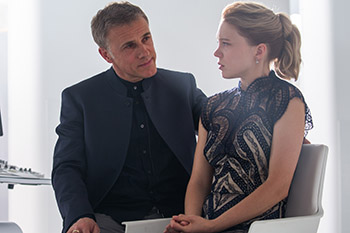 Which brings us to Franz Oberhauser (Christoph Waltz), the central villain of the piece, and yet another ghost from Bond’s past. Like most of the Bond baddies, Waltz is polite and sinister, with a predilection for convoluted torture (inspired by Kingsley Amis’ Bond novel Colonel Sun, which marks the first time that EON Productions has utilized non-Fleming literary material in its work). He is perfectly serviceable as the Root of All Evil, but Mendes (and the script) can’t leave it at that — they must provide him with a Cain and Abel-style link to Bond to escalate their rivalry into Biblical realms. It won’t be revealed here whether Oberhauser is indeed Ernst Stavro Blofeld (“Blofeld Begins,” anyone?); suffice to say that he and Bond’s shared familial history veers the whole enterprise into comic-book territory (and a bad comic book at that). Whatever Skyfall‘s faults as a Bond movie, at least its narrative progress was momentous, its antagonist’s motivations crystal clear: Javier Bardem’s Silva was a betrayed MI6 agent, Bond’s mirror image, seeking revenge against M, full stop. SPECTRE sketches in an unconvincing past for Bond and Oberhauser, and then lets the idea sit there. It’s as if the filmmakers have realized they’ve lobbed a grenade into the room, and no one has the guts to pick it up. Though the script stops short of stating that Oberhauser formed SPECTRE to get back at 007 (a truly ludicrous idea), it doesn’t do much to dispel that implication, leaving the character, and Bond’s reaction to him, at sea.
Which brings us to Franz Oberhauser (Christoph Waltz), the central villain of the piece, and yet another ghost from Bond’s past. Like most of the Bond baddies, Waltz is polite and sinister, with a predilection for convoluted torture (inspired by Kingsley Amis’ Bond novel Colonel Sun, which marks the first time that EON Productions has utilized non-Fleming literary material in its work). He is perfectly serviceable as the Root of All Evil, but Mendes (and the script) can’t leave it at that — they must provide him with a Cain and Abel-style link to Bond to escalate their rivalry into Biblical realms. It won’t be revealed here whether Oberhauser is indeed Ernst Stavro Blofeld (“Blofeld Begins,” anyone?); suffice to say that he and Bond’s shared familial history veers the whole enterprise into comic-book territory (and a bad comic book at that). Whatever Skyfall‘s faults as a Bond movie, at least its narrative progress was momentous, its antagonist’s motivations crystal clear: Javier Bardem’s Silva was a betrayed MI6 agent, Bond’s mirror image, seeking revenge against M, full stop. SPECTRE sketches in an unconvincing past for Bond and Oberhauser, and then lets the idea sit there. It’s as if the filmmakers have realized they’ve lobbed a grenade into the room, and no one has the guts to pick it up. Though the script stops short of stating that Oberhauser formed SPECTRE to get back at 007 (a truly ludicrous idea), it doesn’t do much to dispel that implication, leaving the character, and Bond’s reaction to him, at sea.
 The revelation of Waltz’s identity kneecaps any momentum SPECTRE has; the story sputters in its final act with a not-very-thrilling race against the clock in London (for a series known for its big finishes, this leaves an especially bitter aftertaste). Ambitiously, the movie wants to wrap a bow on all the previous Craig entries by offering him the opportunity to walk away from all this tragic spy stuff, with Madeleine the light at the end of the tunnel. The idea of giving Bond a resolution isn’t a bad one — with all he’s been through in his previous movies, it probably seemed worthwhile to have him come to terms with his tragedies. But to have him desert Queen and country on a whim? That’s like Batman deciding not to be Batman any more because he lost his girlfriend (oh wait, that happened). As with a lot of other things in this movie, the idea is rushed into being, with little groundwork laid for it. Seydoux, like Waltz, struggles under the extra burden placed on her character; as a winsome, sympathetic Bond heroine she’s more than fine, but she’s not given nearly enough to convince us that she’s the woman who could be his salvation.
The revelation of Waltz’s identity kneecaps any momentum SPECTRE has; the story sputters in its final act with a not-very-thrilling race against the clock in London (for a series known for its big finishes, this leaves an especially bitter aftertaste). Ambitiously, the movie wants to wrap a bow on all the previous Craig entries by offering him the opportunity to walk away from all this tragic spy stuff, with Madeleine the light at the end of the tunnel. The idea of giving Bond a resolution isn’t a bad one — with all he’s been through in his previous movies, it probably seemed worthwhile to have him come to terms with his tragedies. But to have him desert Queen and country on a whim? That’s like Batman deciding not to be Batman any more because he lost his girlfriend (oh wait, that happened). As with a lot of other things in this movie, the idea is rushed into being, with little groundwork laid for it. Seydoux, like Waltz, struggles under the extra burden placed on her character; as a winsome, sympathetic Bond heroine she’s more than fine, but she’s not given nearly enough to convince us that she’s the woman who could be his salvation.
And what are we to make of Craig’s more relaxed turn as Bond if this is indeed his valediction in the role? “I think you’re just getting started,” Moneypenny tells him at the beginning of the movie, and certainly he doesn’t seem nearly as glum as in previous movies, so why give it all up now? Perhaps the answer lies with Craig himself, and his much-reported statement that he’s “through” with Bond. Coyly, the movie holds out the idea that he might not be completely done, and if SPECTRE goes on to gross another billion, you can be sure that he will be enticed back. But where can we go from here? We’ve covered Oedipal drama and Cain-and-Abel rivalry in the last two films; is it possible for Craig to ever be comfortable headlining a more standard adventure that isn’t bogged down with drama and motivation, and embracing the essential lightness of being James Bond? And would that fly with audiences who have been conditioned to look askance at a “standard” Bond movie at this point? Craig has done well to rescue Bond from the clutches of cliché, but he and his producers have now reached a different kind of creative cul-de-sac. One thing is certain: James Bond will return. What is far from certain is what form he will take, and whether we’ll see another revival of the character and his world, or whether we’ll witness another backslide from respectability, and relevance.

